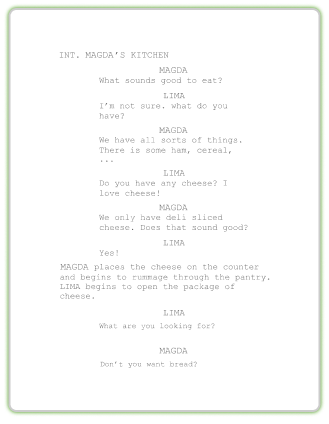With one click
Export a perfectly formatted traditional script.
Sometimes the thought of writing something terrible prevents me from writing anything at all. But the feeling doesn’t last, A) because I’ve trained myself to break through that barrier, and B) because I don’t get paid if I don’t write! The latter is very motivating, but not something that most screenwriters can rely on regularly. No, your inspiration must come from yourself. So, what do you do when you can’t seem to get past your screenplay’s title page? New York Times Bestseller Jonathan Maberry has some advice for how to start a screenplay and write the perfect first page, and it begins with letting go of perfection.
Export a perfectly formatted traditional script.


“Writing the perfect first page is an interesting challenge,” he told us in an interview. “In the first draft, you’re not going to do that.”
So, let yourself off the hook! According to Maberry, who also won a Bram Stoker Award (okay, I’m listening!), setting the standard of “perfect” in your writing is self-defeating, because no work is ever perfect. Even HE has looked back on his first New York Times Bestseller and wanted to change things.
“Looking back at it eight or nine years later, I could say “I would like to change that, that, that,” he said.
“Do the best you can do that day, and also understand its relevance to the final project. The first draft is just a story. All the figurative and descriptive language, the metaphor and subtext, those are things that are going to come later and be worked into it during revision phase,” Maberry explained. “What you need to do is write the first page that keeps you interested enough to write the next one. Write the story that’s going to keep you interested in doing the next page, and the next, and the next.”
A compelling location
A first moment to hook the audience (see below)
Words with purpose that set the tone for how the story will unfold
An introduction to your protagonist
Set the pace of the script
Now that you know how to start a screenplay, revise the first page keeping in mind these ten ways to really hook your reader, according to writer Ann Garvin for Writer’s Digest and adapted for screenwriters.
Begin at a critical moment
Add an unusual situation
Include an alluring character
Insert conflict
Include the antagonist
Create a change in emotion
Add irony or surprise
Make the reader curious
Apply the dread factor
Keep the dialogue or action compelling
Ready to move past page 1? Don’t miss out on these ten tips to write the first ten pages of your screenplay. It’s a must-read, because you need to make the first ten pages count.
Tell me something interesting,